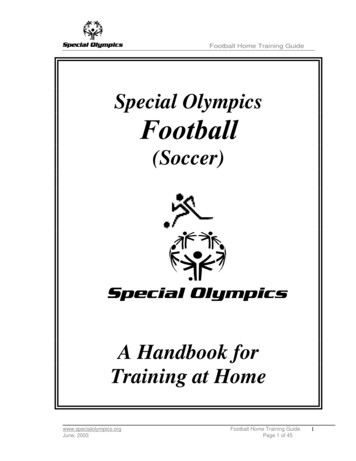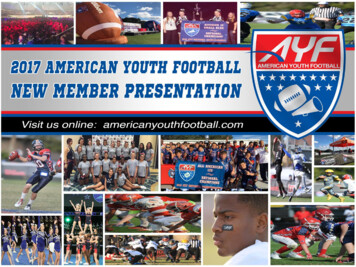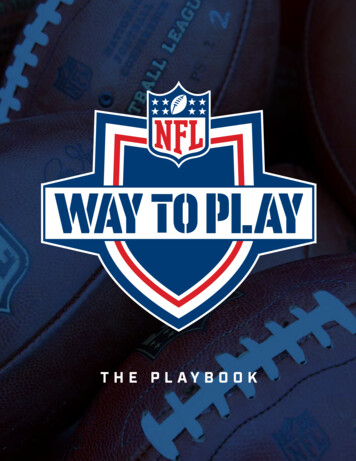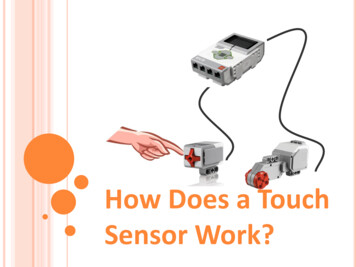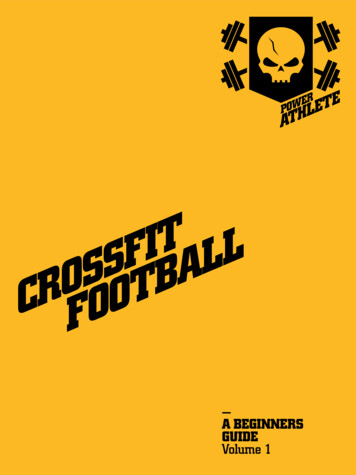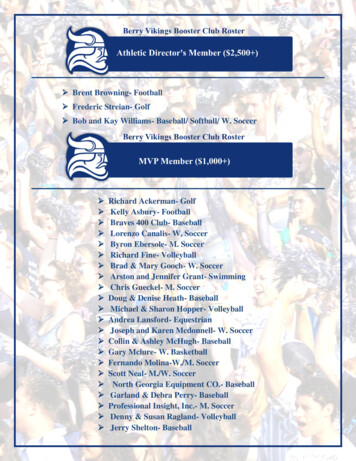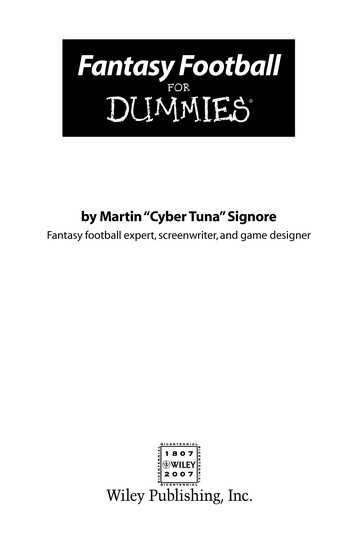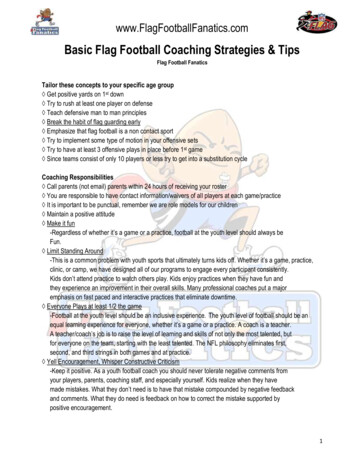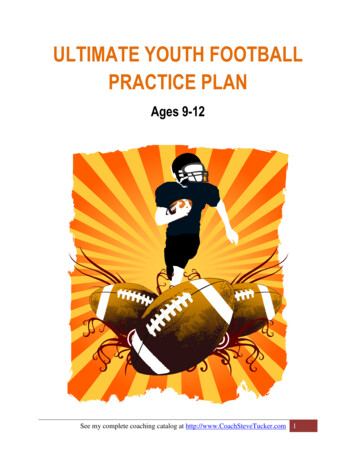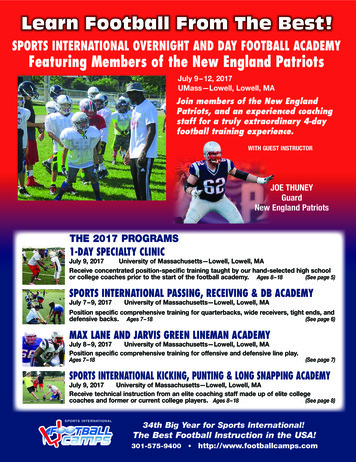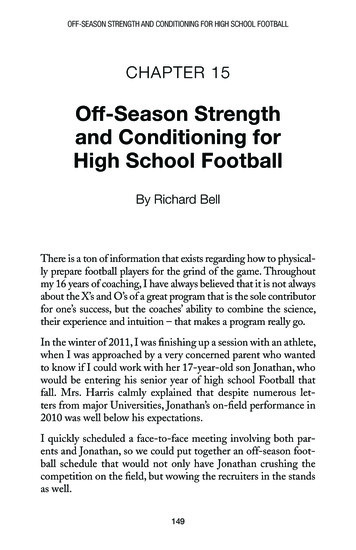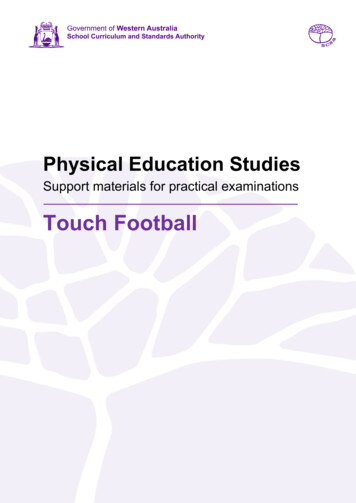
Transcription
Physical Education StudiesSupport materials for practical examinationsTouch Football
School Curriculum and Standards Authority, 2011This document—apart from any third party copyright material contained in it—may be freely copied, or communicated on anintranet, for non-commercial purposes in the educational institutions, provided that the School Curriculum and Standards Authorityis acknowledged as the copyright owner, and that the Authority’s moral rights are not infringed.Copying or communication for any other purpose can be done only within the terms of the Copyright Act 1968 or with prior writtenpermission of the School Curriculum and Standards Authority. Copying or communication of any third party copyright material canbe done only within the terms of the Copyright Act 1968 or with permission of the copyright owners.Any content in this document that has been derived from the Australian Curriculum may be used under the terms of the CreativeCommons Attribution-Non Commercial 4.0 International (CC BY) licence.2009/8142v5
IntroductionThe purpose of these materials is to support teachers and candidates in preparation for thePhysical Education Studies practical examination.Skills set for touch footballThese materials outline the examinable skills set for touch football. Five (5) of the skills,selected by the examination panel, will be examined and these will be communicated to thecandidates at the commencement of the examination.Observation pointsObservation points are provided for each skill in the skills set. They are provided for thepurpose of teaching and coaching and are designed to assist examination candidates in theirpersonal skill development.Examination drillsThe examination will contain a number of drills through which the selected skills will beassessed. These materials outline a number of drills indicative of the types of drills in which thecandidates will participate during the examination and may form part of a teaching program.Tactical frameworkIn the game performance section of the examination, candidates will participate in a modifiedcompetitive situation, which will be based on some of the tactical problems in touch football.The tactical problems for the examination are outlined in the tactical framework and will beselected by the examination panel. The skills that provide the basis for the solutions to thesetactical problems are also included in the framework.In the game performance section of the touch football examination, students will be assessedon the execution of skills, use of space, positioning and decision making that effectively solvethe tactical problems presented by the modified competitive situation.
CONTENTSPAGE NUMBERTouch football skills set5Skills set and observation points6Touch football drills10Drill descriptions11Tactical framework29Touch Football practical examination support materials3
Skill numberName of skillPage number1Running pass62Lateral pass63Catch64Half pass (long ball)75Half pass (pop)76Effecting a touch – attacker (dump/roll ball)77Dummy pass88Evading side step89Spiral pass810Scoring a touchdown911Effecting a touch -defender912Scoop9Touch Football practical examination support materials4
1.RUNNING PASSPreparation Ball is held with two hands oneither side with fingers spread andelbows slightly bent Body is balanced with the outsideleg forward and the body turnedtowards the receiver Eyes are looking towards the target Ball is carried in front of the bodyExecution Upper torso rotates to swing theball across the front of the body Weight is transferred onto the footclosest to the target Velocity and angle of pass isappropriate to distance required Flexion of the wrists directs the balltowards the receiverConclusion Follow through is balanced withfingers pointed towards thereceiver Ball travels backwards with a flattrajectory Ball is received by team-matebetween the shoulders and waist Receiver is able to run onto theball Player repositions and is availablefor a pass2.LATERAL PASSPreparationExecution Ball is held with two hands oneither side with fingers spread Upper torso rotates to swing theball across the front of the body Body is balanced with the outsideleg forward and the body turnedtowards the receiver Weight is transferred onto the footclosest to the target Eyes are looking towards the target Ball is carried in front of the body Velocity and angle of pass isappropriate to distance required Flexion of the wrists directs the balltowards the receiverConclusion Follow through is balanced withfingers pointed towards thereceiver Ball travels backwards with a flattrajectory Ball is received by team-matebetween the shoulders and waist Team mate is able to run onto theball Player repositions and is availablefor a pass3.CATCHPreparation Body is balanced with feet shoulderwidth apart Arms slightly flexed with palmsfacing inwards at waist level Body position is adjusted relative toplayer passing the ball and flight ofthe ballExecution Hands are extended with fingersspread and pointing in the directionof the ball Fingers and elbows flex on impactto absorb forceConclusion Ball is guided into control with a‘giving’ action The next pass or movement isanticipated Ball is caught towards the mid-lineof the body Flight path of the ball is followed allthe way into the handsTouch Football practical examination support materials5
4.HALF PASS (long ball)PreparationExecution Outside foot is placed near theball A single movement is used toswing the ball from the ground Ball is held with two hands oneither side with fingers spreadand elbows slightly bent Upper torso rotates to swing theball across the front of the body The player looks at the receiverafter securing the ball Velocity and angle of pass isappropriate to the distancerequired Base of support is wide andbalanced with inside foot towardsthe receiver Weight is transferred onto the footclosest to the target5. Follow through is balanced withfingers pointed towards thereceiver Ball travels backwards and spiralswith a flat trajectory Ball is received by team-matebetween the shoulders and waist Team-mate is able to run onto theball Player repositions and is availablefor a passHALF PASS (pop)PreparationExecution Base of support is wide and theball is swung across the body The ball is secured with bothhands Outside foot is positioned near theball Relative position of team-matereceiving the pass is monitored Inside foot is facing towards thereceiver Ball is directed through flexion ofthe wrists Hips and knees flex to allow forpick-up of the ball Ball is flicked slightly backwardsinto space for the oncomingrunner 6.ConclusionVelocity and angle of pass isappropriate to the distancerequiredConclusion Follow through is balanced withfingers pointed towards thereceiver Ball travels backwards Ball floats or ‘hangs’ with no spin Ball is received by team-matebetween the shoulders and waist Team-mate is able to run onto theball Player repositions and is availablefor a passEFFECTING A TOUCH – ATTACKER (dump/roll ball)PreparationExecution Balance is maintained by loweringbody position Knees and the hips flex to lowerthe base of support Body is positioned to one side ofthe defender Ball is controlled in a secureposition The player decelerates inanticipation Eyes are focused on the hips ofthe defenderHand nearest the defender isextended to initiate the touch onopponent with minimal force Touch is effected at hip heightTouch Football practical examination support materialsConclusion Ball is controlled to the groundjust in front of or between the feetthat are parallel to the sidelines Player steps forward and squareover the ball Player repositions and is availablefor a pass6
7.DUMMY PASSPreparation Ball is held with two hands oneither side and with fingersspread Body is balanced with outside legforward and body turned towardsthe receiver Eyes are looking towards thetarget and peripheral vision isused to demonstrate awarenessof opposition Ball is carried in front of the body8.ExecutionConclusion Ball is swung across the front ofthe body Ball is held firmly and returned tonormal carrying position Full range of motion of the uppertorso is used to achieve deception Opponent is successfullydeceived Arms are fully extended as if theball is going to be passed Player shows awareness offurther options Acceleration occurs as thedummy is completedEVADING SIDE STEPPreparationExecutionConclusion Balance is maintained during therun Body weight is transferredtowards the stepping leg Acceleration is away from theopponent at a new angle Control of the ball is maintained Defender is out of position A slight step to the sideestablishes a wider base ofsupport and forces defender tocommit to a lateral movementThe body feints towards thestepping side Knee is extended to achieve apush off the ball of the foot in theopposite direction Player shows awareness offurther options Shoulders are rotated slightlyaway from opponent9.SPIRAL PASSPreparation Outside-hand is nearer to the rearof the ball whilst the inside hand isnear the front Body is balanced with outside legforward and body turned towardsthe receiver Eyes are looking towards thetargetExecution Inside leg steps towards thetarget Front end of the ball is pointedslightly higher towards thereceiver and swung across thefront of the body with two hands As the ball is delivered the outsidehand rotates over the ball toimpart spin Velocity and angle of pass isappropriate to the distancerequired Wrist flexion directs ballbackwards towards the receiverTouch Football practical examination support materialsConclusion Follow through is balanced withfingers pointing towards thereceiver Ball travels with a flat trajectory Ball is received by team-matebetween the shoulders and waist Team-mate is able to run onto theball Player repositions and is availablefor a pass7
10.SCORING A TOUCHDOWNPreparation Location of score line is identified Acceleration towards the scoreline Body leans forward in preparationto lower the body Knee and hip flexion lowers thebody11.Conclusion Arms and body stretchdownwards reaching on orbeyond the score line Downward pressure is applied tothe ball once on or over the scoreline Ball is held securely in one or twohands Balance is maintained throughoutEFFECTING A TOUCH – DEFENDERPreparation Balance is maintained by loweringbody position Body is positioned in front of theattacker Acceleration is towards attackingplayer Eyes are focused on the lowertrunk of the attacker12.ExecutionExecution Hand nearest the attacker isextended to effect the touch onopponent with minimal force Touch is effected at shoulderheightConclusion Defender regains balance andretreats to onside positionSCOOPPreparationExecutionConclusion Outside foot is positioned side-onand near the ball Balance and speed aremaintained throughout Extend through the hips to getback to upright position Hips and knees flex to allow forlow pick up Arms swing across the body toscoop up the ball in one hand Player shows awareness offurther options Eyes are focused on the ball Hands are positioned to securethe ball and lift it off the groundTouch Football practical examination support materials8
Drill numberPage number1Catch, lateral pass, spiral pass112Scoring a touchdown, effecting a touch – defender,evasion123Half pass (long ball)134Half pass (pop)145Scoop, effect the touch – attacker (dump/roll ball)156Scoop, evading a side step, scoring a touchdown167Effect the touch – attacker (dump/roll ball), half pass (longball), evading a side step178Catch, running pass189Catch, half pass (pop)1910Catch, lateral pass, spiral pass2011Effecting a touch – attacker (dump/roll ball), effectingtouch – defender, scoring a touchdown2112Scoop, evading a side step, scoring a touchdown2213Catch, running pass, dummy pass2314Catch, running pass, lateral pass, spiral pass, scoring atouchdown2415Catch, running pass, scoring a touchdown2516Scoop, running pass, effect the touch – attacker(dump/roll ball) lateral pass2617Effect the touch – attacker (dump/roll ball), half pass(pop), catch2718Catch, lateral pass, running pass, dummy pass, effect thetouch – attacker (dump/roll ball), effecting touch –defender, scoring a touchdown, half pass (pop), scoop28These drills are indicative of the types of drills in which the candidates will participate during theexamination and may form part of a teaching program.Touch Football practical examination support materials9
Drill 1:Catch, lateral pass, spiral passX2X5X1X6X3X4KeyX player player movementO feeder----- ball movement markerDrill description1.Ball is to be passed around the outside of the rectangle.2.Players on the corners (X1, X2, X3 and X4) must run diagonally across the square to theopposite corner once they have passed the ball.3.Players in the middle of each side (X5 and X6) must run across the square once theyhave passed the ball.4.Change direction to test other passing side.Touch Football practical examination support materials10
Drill 2:Scoring a touchdown, effecting a touch – defender, evasionX2X1KeyX player player movementO feeder----- ball movement markerDrill description1.On the command ‘go’, the attacker (X2) (with the ball) must run around marker and backto score a touchdown before the defender (X1) effects a touch.The defender (X1) should effect the touch from the side or behind.Touch Football practical examination support materials11
Drill 3:Half pass (long ball)KeyX player player movementO feeder----- ball movement markerDrill description1.Players work in pairs in rollball and acting half positions.2.Rollball is performed, then ball is passed to the next pair off the ground from acting halfposition.3.Process is repeated and ball is passed around the square.4.Players stay in pairs but swap positions.5.Reverse direction to test the other passing side.Touch Football practical examination support materials12
Drill 4:Half pass (pop)X3X4X1X2X3X4X1X2X3X4X1X2X3X4KeyX player player movementO feeder----- ball movement markerDrill description1.Players work in pairs in rollball and acting half positions.2.X1 starts with the ball, runs to first marker and performs rollball.3.X2 runs into acting half position and sends half pass to X3 who receives the ball on therun.4.X3 continues running to the first marker and performs rollball.5.X4 sends half pass to X1 who receives the ball on the run.6.Continue process to end marker.7.Change positions on return run.
Drill 5:Scoop, effect the touch – attacker (dump/roll ball)scoopDscoop5mX1X2KeyX player player movementO feeder----- ball movement markerDrill description1.X1 runs from the first marker, picks up the ball at the second marker (scoop), passes toX2 who effects the touch on a stationary defender and performs rollball at the thirdmarker then runs through.2.Repeat the process at the next two markers.3.After turning at the last marker, repeat the same process using the non preferred hand.4.Upon completion X1 and X2 swam positions and repeat.Touch Football practical examination support materials14
Drill 6:Scoop, evading a side step, scoring a touchdownX1X2X2X1KeyX player player movementO feeder----- ball movement markerDrill description1.Defender (X2) moves sideways around the first marker, then forwards to place ball onthe ground beside the second marker and then begins retreating backwards to the firstmarker.2.Attacker (X1) scoops up the ball, accelerates/steps in either direction past the defender.3.Once defender retreats 5m, they can turn and chase the attacker to prevent them fromscoring.Note: Defender cannot change direction until she/he has retreated 5m.Touch Football practical examination support materials15
Drill 7:Effect the touch – attacker (dump/roll ball), half pass (long ball), evading a side stepX4X45mX2X1X3X2X1KeyX player player movementO feeder----- ball movement markerDrill description1.X2 (with the ball) and X1 run around markers. X2 effects the touch and dumps on X4 (thedefender) and X1 goes into acting half.2.X4 retreats 5m to the marker.3.X1 passes long ball (10m) from the ground to X3.4.X3 receives the ball on the run and attempts to score over the scoreline without gettingtouched.5.X4 must try to effect the touch on X3.Touch Football practical examination support materials16
Drill 8:Catch, running passX3X3X2X2X1X1X1XX2XXX3KeyX player player movementO feeder----- ball movement markerDrill descriptionPart 11.Ball starts at X3.2.X3 taps the ball, runs with the ball a few metres then passes to X2 who receives the ballon the run, runs a few metres and passes the ball to X1.3.All players run around their end markers (X1 still has the ball).Part 24.On return, X1 passes the ball to X2 on the run, who runs a few metres and passes off toX3.5.Reverse the drill to test other passing side.Touch Football practical examination support materials17
Drill 9:Catch, half pass (pop)X3X4X2X1X1X2KeyX player player movementO feeder----- ball movement markerDrill description1.X1 starts with the ball, runs a few metres and passes to X2 who receives the ball on therun.2.X2 then accelerates on an angle towards the area where the pass came from.3.X1 accelerates behind X2 in a loop.4.X2 passes the ball to X1 who receives the ball on the run in the gap outside X2.5.Pass off to next pair to perform wrap on return run.Variation1.X1 starts with the ball, runs a few metres and passes to X2 who receives the ball on therun.2.X2 then accelerates on an angle between defenders (X3 and X4) to draw X4.3.X1 accelerates behind X2 in a loop.4.X2 passes the ball to X1 who receives the ball on the run in the gap outside X4 andscores.Touch Football practical examination support materials18
Drill 10:Catch, lateral pass, spiral passX3X4X1X2KeyX player player movementO feeder----- ball movement markerDrill description1.X1 starts with the ball and runs past the first marker, then on an angle diagonallytowards the second marker.2.X2 runs towards the first marker, then diagonally towards the second marker, ensuringabout two metres distance between X1 and X2.3.X2 receives the pass from X1 who has waited until X2 is directly behind them beforerotating their body in the direction of X2.4.X2 straightens towards the third marker and repeats the above process, passing to X1.Variation1.X1 starts with the ball and runs past the first marker, then on an angle diagonally, takingon defender X3 on the outside.2.X3 starts at the edge of the grid and attempts to touch the ball carrier.3.X2 runs straight, then diagonally to accept the pass from X1.4.X2 receives pass from X1 who has waited until X2 is directly behind them before rotatingtheir body in the direction of X2.5.X2 straightens and scores over the end line.Touch Football practical examination support materials19
Drill 11:Effecting a touch – attacker (dump/roll ball), effecting touch – defender, scoring atouchdownX3X1 X2X3X2X1X2KeyX player player movementO feeder----- ball movement markerDrill description1.X2 runs with the ball and positions body to one side of defender (X3).2.Defender runs toward attacker (X2), decelerating, and remaining balanced to effect thetouch.3.X2 and X3 effect the touch, X2 then performs a rollball for X1 then splits.4.X3 retreats backwards 5m.5.X1 passes off the ground to X2 who attempts to score a touchdown.6.X3 attempts to effect a touch on X2 to stop the touchdown from being scored.Touch Football practical examination support materials20
Drill 12:Scoop, evading a side step, scoring a touchdownX5X6X4X2X3X1KeyX player player movementO feeder----- ball movement markerDrill description1. Ball is placed beside the marker and X4 (defender) lies face down on the ground.2. X1 (attacker) scoops the ball and runs over the score line looking for attacking support.3. When X1 has touched the ball, X4 can get up off the ground and chase X1.4. X2 and X3 (attackers) must try and provide a scoring option for X1 to pass to and score.5. X5 and X6 (defenders) must chase their opponents and stop them from scoring.Touch Football practical examination support materials21
Drill 13:Catch, running pass, dummy passX5X4X3X1X2XXKeyX player player movementO feeder----- ball movement markerDrill description1.Players work in pairs to beat defenders (X3–X5).2.Defenders can only move sideways, not forwards or backwards.3.X1 must draw defender then pass to X2 who is running in an onside position.4.X2 then runs and draws second defender then passes to X1 who is running in an onsideposition (repeat process).5.If defender does not commit, attacker can throw a ‘dummy’ and continue to next markerwithout passing.Touch Football practical examination support materials22
Drill 14:Catch, running pass, lateral pass, spiral pass, scoring a touchdownX4X5X2X6X1X3X1X2X3KeyX player player movementO feeder----- ball movement markerDrill description1.X1 (attacker) runs a few metres with the ball then passes to X2 (attacker) who receivesthe ball on the run.2.X2 then straightens into the gap between defenders X4 and X5, commits X5, then passes(appropriate pass) to X1 who is straightening into gap between defenders X5 and X6.3.X1 to score or draw X6 and pass to X3 (attacker) hitting outside gap.Touch Football practical examination support materials23
Drill 15:Catch, running pass, scoring a touchdownX1X4X5X3X6X2X1X2X3KeyX player player movementO feeder----- ball movement markerDrill description1.X1 runs forward with the ball and passes off to X2 who receives the ball on the run.2.X2 runs straight to draw the defender X5, and then accelerates on an angle betweendefenders X5 and X6.3.X3 runs straight, then on an angle to receive the ball behind X2, then accelerates on theangle between defenders X4 and X5.4.X3 can score or draw defender X4 and then pass off to X1 who scores the touchdown.Touch Football practical examination support materials24
Drill 16:Scoop, running pass, effect the touch – attacker (dump/roll ball) lateral passX5X6X7X4X3X4X2X1X2X1X3X4KeyX player player movementO feeder----- ball movement markerDrill description1.Attackers X3 (with the ball) and X4 run around the markers. X3 dumps on X7 (defender)and X4 goes into acting half.2.X4 scoops up ball and runs on angle at gap between defenders X6 and X7.3.X4 must draw X6 then pass to X2 or X1 depending on the reaction of X5 (i.e. if X5 goes toX2, X4 throws spiral pass to X1. Alternatively if X5 does not go towards X2, X4 needs tothrow short pass to X2).4.X1 and X2 need to be running hard and from depth at the gaps in front of them to assistX4’s decision-making process.Touch Football practical examination support materials25
Drill 17:Effect the touch – attacker (dump/roll ball), half pass (pop), catchX4X1X3X2X4X2X1X3X4X2X3X1X1X3X2KeyX player player movementO feeder----- ball movement markerDrill description1.Players work in teams of three (X1, X2 and X3) plus one defender (X4).2.X1 performs a rollball at the first marker, X2 gives a half pass to X3 who receives the ballon the run and hits angle toward X4.3.X3 effects the touch on X4 (who retreats backwards to the next marker) and performsrollball.4.X1 moves into acting half and passes the ball to X2 who is running from first off position.5.Repeat above process for 3-4 markers.Touch Football practical examination support materials26
Drill 18:Catch, lateral pass, running pass, dummy pass, effect the touch – attacker(dump/roll ball), effecting touch – defender, scoring a touchdown, half pass (pop), scoop15mX515mX5X4X1 X2 X3X4X1X2X3KeyX player player movementO feeder----- ball movement markerDrill description1.At the same time, two defenders (X4 and X5) run around the end marker and into thegrid and three attackers (X1, X2, X3) (one with the ball) run around the opposite endmarker and into the grid.2.The attackers must then draw and pass in an attempt to score over the defenders’scoreline.3.The defenders must communicate and attempt to stop the attacking team from scoringby making a touch, forcing a dropped ball or intercepting a pass.Progression 1: add ‘one touch’ to the game.1.Players enter the grid (as above) and the attacking team has one touch to use in orderto score.2.Defenders must effect the touch and retreat 5m (or to the scoreline) as per game rules.Progression 2: 4 on 31.As per above, but four attackers and three defenders enter the grid.2.Increase width from 15m to 20m.Progression 3: 4 on 3 plus ‘one touch’1.As per progression 1 with four attackers and three defenders.Progression 4: 4 on 4 plus ‘3 touches’1.Teams of four attack and defend for three touches.2.Increase width from 20m to 30m.Touch Football practical examination support materials27
Touch Football tactical frameworkTactical ProblemsSCORING (OFFENSE)Off-the-ball skillsMaintaining possession of the ball Support- running with the ballcarrier Line Attack WidthExecute set playsSet behind the ball carrierPositioning in space (running holes)Lateral movement (positionadjustment) Running with the ballEffective passing – travellingbackwards (left to right, right to left,long ball, short ball, pop ball)Effecting a mistake free roll ballDrawing or moving a defenderRunning into spaceScoring a touchdownEffective roll ballsExecute set playsGood positioning of acting halfDiving to score WidthExecute set playsSet behind the ball carrierPositioning in space (running holes)Lateral movement (positionadjustment)Timing of run to take flat pass fromacting half Drawing a defenderRunning forward in possessionRunning onto the ballScoring a touchdownEffective roll ballsExecute set playsGood positioning of acting halfDiving to scoreRucking towards the line PREVENTING SCORING (DEFENCE)Line DefenceRuck DefenceOn-the-ball skillsReducing spaceProtecting short sidesCommunicationMoving forwards at a slower paceUnderstanding of basic policies i.ewinger never makes a touch Get in front of the ballTwo handed touchesRetreat quicklyProtecting short sidesDiving touchTaking the tapCommunicationReducing spaceProtecting short sidesCommunicationSetting early/getting onside to prepareto shoot up Understanding of basic policies i.ewinger never makes a touch Get in front of the ballTwo handed touchesRetreat quicklyAttempt to shoot up in order to keepthe ball as close to own score line aspossibleCommunicationProtecting short sidesDiving touchTaking the tap RESTARTING PLAYAfter a penalty, roll ball, or touch down WidthPrepare for set playsSet behind ball carrierCommunicationTouch Football practical examination support materials Correct tap or roll ball Prepare for set plays Communicate28
Skills set for touch football . These materials outline the examinable skills set for touch football. Five (5) of the skills, selected by the examination panel, will be examined and these will be communicated to the candidates at the commencement of the examination. Observation points .
